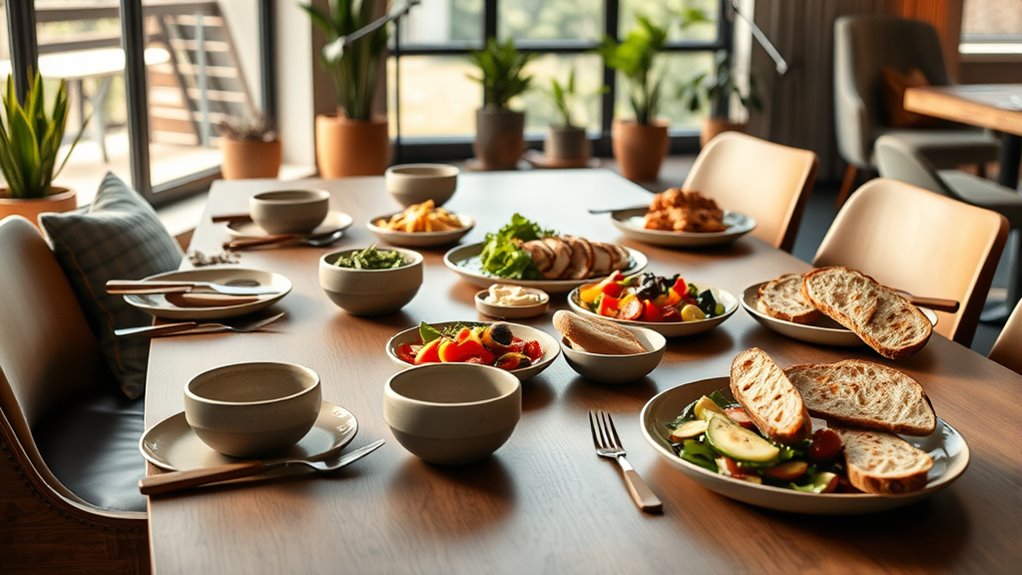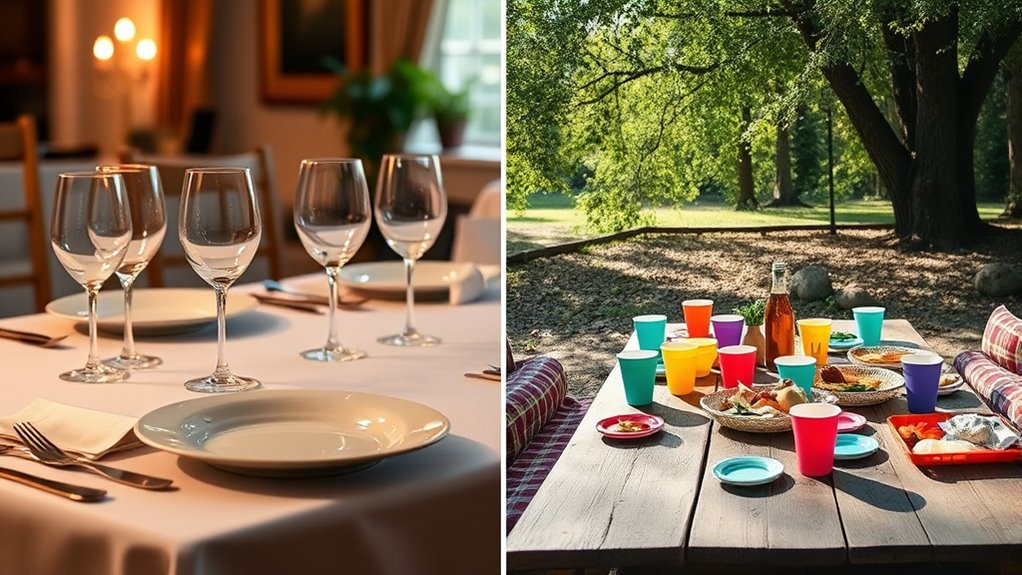The way you approach dinner has shifted from formal, multi-course meals to casual, convenience-focused gatherings that prioritize comfort and authenticity. Today, casual dining is all about relaxed atmospheres, quick meals, and sharing with loved ones without the pressure of perfection. Technology makes it easier to access quick recipes or order food on demand. If you keep exploring, you’ll discover how these changes are reshaping your mealtime habits and social interactions.
Key Takeaways
- Casual dining now prioritizes relaxed atmospheres over traditional formal settings and elaborate tableware.
- Mealtime routines are more flexible, with quick, homemade, or delivered meals replacing scheduled, multi-course dinners.
- Technology facilitates convenient food ordering and sharing simple recipes, supporting spontaneous and casual eating habits.
- Social expectations emphasize authenticity and connection over formality, with casual environments like pajamas or parks gaining popularity.
- Broader cultural shifts focus on comfort, nourishment, and enjoyment, moving away from the idea of dinner as a luxurious, time-consuming event.

Have you noticed how dinner habits are shifting in ways you mightn’t expect? Gone are the days when formal sit-down dinners with multiple courses and matching china were the norm for most families. Today, casual dining has taken center stage, transforming how you approach mealtime. The traditional idea of a dinner as a luxurious, time-consuming event is giving way to quicker, more relaxed experiences.
You might find yourself grabbing a bowl of cereal or a sandwich in front of the TV instead of preparing an elaborate meal. The rise of fast casual restaurants and food delivery services reflects this change, making it easier to enjoy a satisfying meal without the fuss.
Casual meals like cereal or sandwiches now often replace elaborate dinners, reflecting a shift toward convenience and simplicity.
This shift isn’t just about convenience; it’s also about the atmosphere and social expectations surrounding dinner. You no longer need to dress up or set a formal table to enjoy a meaningful evening meal. Instead, casual settings—whether in your pajamas, at a park, or around a shared countertop—are becoming more popular.
This relaxed approach makes it easier to connect with loved ones without the pressure of perfection or formality. You might find yourself sharing a pizza with friends or a quick homemade dinner with your family without feeling like you’re sacrificing quality or connection.
The way you view the roles of mealtime has also changed. Dinner is becoming less about strict routines and more about flexibility. You might eat at different times of the day, skipping traditional dinner hours altogether or combining meals to suit your schedule.
Meal prepping and batch cooking have gained popularity because they fit into busy lifestyles, allowing you to have a nutritious, homemade meal without the hassle of daily cooking. This practicality encourages a more relaxed, spontaneous approach to eating, where the focus is on nourishment and enjoyment rather than formality.
Technology continues to influence this transformation as well. You’re more likely to use apps to order food or to find quick recipes online. Social media often showcases quick, casual dinners that emphasize flavor and presentation over formality.
This accessibility and emphasis on simplicity mean you can embrace a more laid-back dining style without feeling guilty or rushed. The evolving landscape of dinner reflects broader cultural shifts toward valuing comfort, convenience, and authenticity in your food choices.
As you adapt, you’re part of a movement that celebrates the idea that dinner can be an enjoyable, unpretentious experience—no matter how simple or spontaneous it may be. Additionally, embracing mindfulness practices during meals can enhance your enjoyment and promote healthier eating habits.
Frequently Asked Questions
How Have Dinner Etiquette Norms Evolved Over Time?
You’ve probably noticed that dinner etiquette has shifted from strict formalities to more relaxed customs. Today, you can comfortably eat with your hands, use casual tableware, and share dishes family-style.
Politeness still matters, but the emphasis is on enjoyment and connection rather than rigid rules. You’re encouraged to be yourself, focus on conversation, and make mealtime enjoyable rather than perfect.
This evolution makes dining more accessible and inclusive for everyone.
What Are Popular Casual Dinner Trends Worldwide?
You’ll notice that casual dinner trends worldwide focus on comfort and convenience. You might enjoy potlucks with friends, where everyone brings a dish, or casual dining at home with simple, healthy recipes.
Social media influences this shift, encouraging sharing meals online. Flexible timing and informal settings are common, making dinners more relaxed.
You’re likely to see a blend of global cuisines and a move away from strict table manners, emphasizing enjoyment over formality.
How Does Technology Influence Modern Dinner Gatherings?
You might believe technology isolates us, but it actually transforms your dinner gatherings.
With smartphones, you can share recipes instantly, stream music, or even video chat with friends far away. It keeps everyone connected and engaged, making your meals more interactive and fun.
Technology fosters a sense of community, blending convenience with entertainment, so your dinners become memorable moments rather than just routine.
What Are the Environmental Impacts of Casual Dining?
Casual dining impacts the environment mainly through increased waste and resource use. When you opt for informal meals, you’re often using disposable plates, utensils, and packaging, which contribute to landfill waste.
Additionally, casual dining tends to favor takeout and delivery, leading to higher carbon emissions from transportation.
How Do Cultural Differences Shape Dinner Customs Today?
Cultural differences heavily influence your dinner customs today, shaping what, when, and how you eat. You might find yourself sharing meals with family in Japan, where harmony is key, or enjoying communal dishes in Middle Eastern cultures.
These customs guide your table manners, meal timing, and food choices. By understanding and respecting these diverse traditions, you enrich your dining experience and foster greater cultural appreciation.
Conclusion
So, as dinner dramatically shifts from formal to casual, embrace the evolving experience. Whether you’re hosting or enjoying, let’s love the laid-back, lively luster of relaxed mealtimes. Remember, the future of dining is fun, flexible, and fabulous — so seize the spontaneity and savor the simple moments. Change is charming, after all, and with every casual course, you can create cozy, carefree culinary memories worth cherishing.









